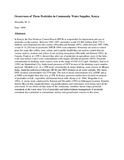| dc.description.abstract | In Kenya, the Pest Products Control Board (PPCB) is responsible for importation and
use of pesticides in the country. Between 1985-1987, pesticides worth US $69
million (Ksh 1732.3 million) were imported into the country (Mwanthi and Kimani
1993), while between 1987-1990, a total of 31,234 tons of pesticides (PPCB 1994)
were imported. Pesticides are used to control pests for crops like coffee, corn,
cotton, and in public health they are used to control disease vectors such as, malaria
and yellow fever carrying mosquitoes (Mwanthi and Kimani 1993).
In Canada, Frank et al. (199 1) showed that after use of pesticides in agriculture, most
of the farm wells and surface waters were contaminated with organo-chlorine
pesticides (OCP). Pesticide contaminants in drinking water sources were in the range
of 0.05 to 0.5 ppb. Similarly, Jani et al. (1991) in Ahmedabad City, India found
presence of OCP in most of the drinking water samples analyzed. Dikshith et al., in
a 1990 study of pesticides in major drinking water sources in Bhopal, India, found
hexachlorocyclohexane (HCH) and DDT residues in all water samples. The mean
DDT residual concentration was 5794 ppb. The sum of mean concentration of p, p'DDE
and p, p'-DDD were higher than that of p, p'-DT.
In Kenya, previous studies have focused on analysis of pesticides in fish, vegetables,
and human breast milk (Kanja et al. 1986; Mugachia et al. 1992). A recent study
conducted by Kimani and Mwanthi (1995) in Githunguri location, Kiambu district
showed that organochlorines, organophosphates and carbamates were being used all
the year round. It was observed that some of the community members rinsed empty
pesticide containers at the water sites. Use of pesticides and indiscriminate
management of pesticide containers have potential to contaminate surface and
groundwater sources in this areas. | en |


